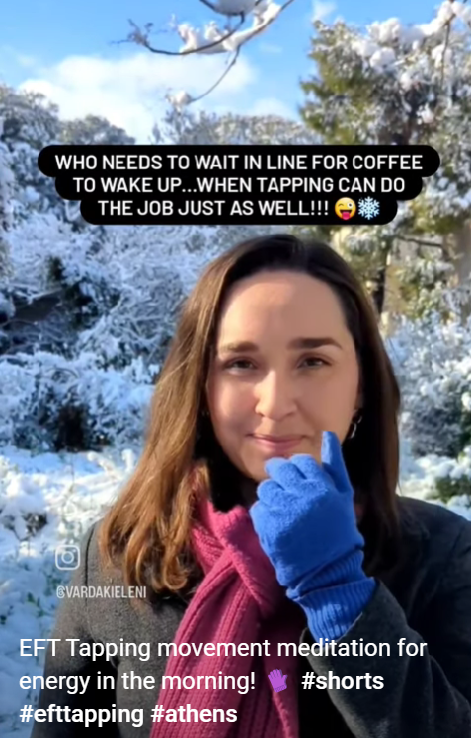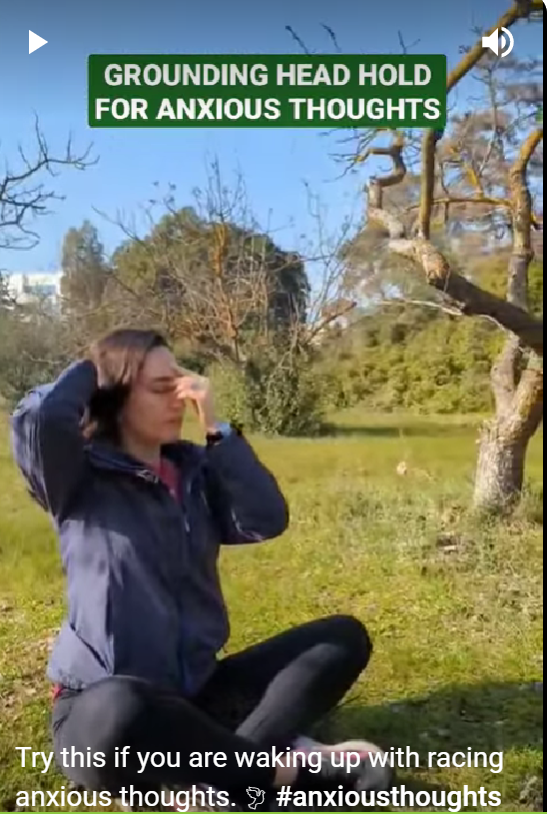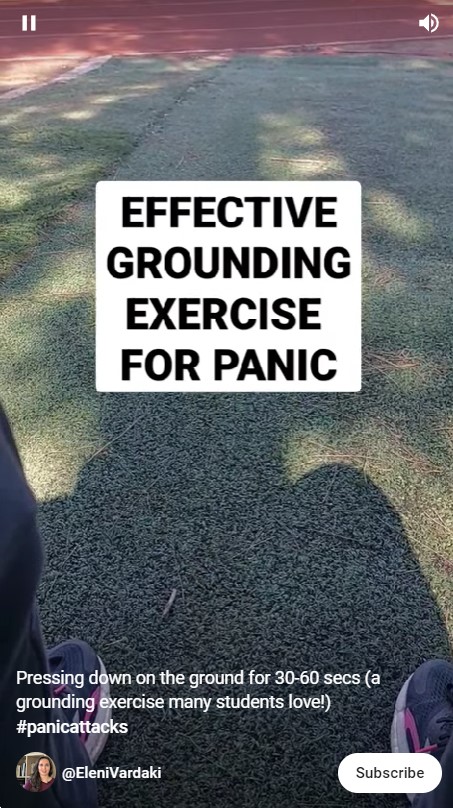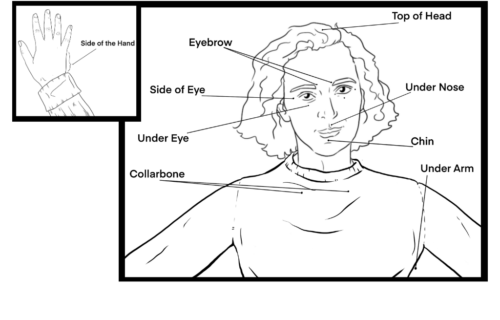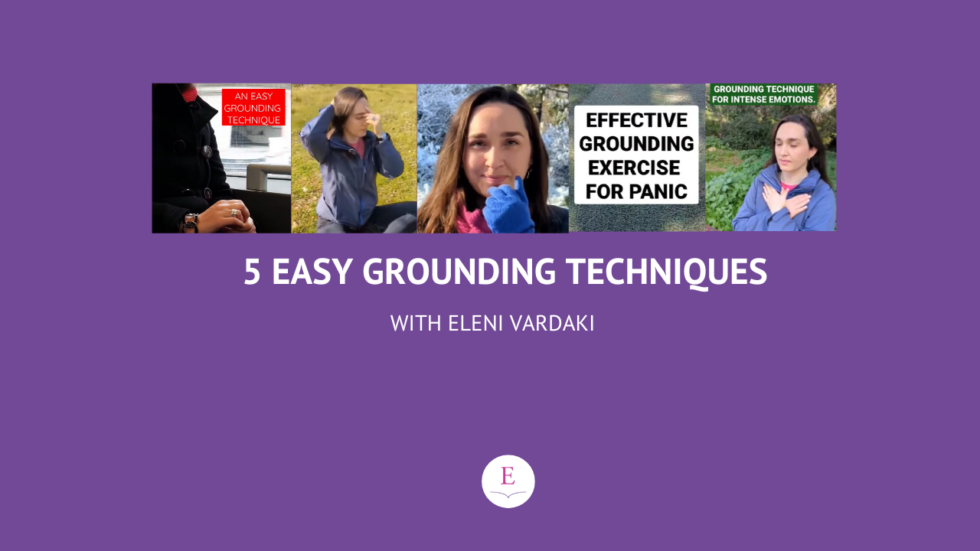
Grounding Techniques for School Staff and Students
WHAT’S UP: If you are new to my site – hi, I’m Eleni! I’m an educator who’s been practicing trauma-informed mindfulness for many years – since February 2012! At first, it was just for my own mental health and well-being as an educator. Eventually, I started teaching these grounding techniques to interested students for academic stress, overwhelm, panic, and anxiety relief.
I never could have imagined that, a decade later, I would be invited to share my ‘toolbox’ of body-based grounding techniques for teacher and student well-being with interested members of staff…in two of Greece’s leading international schools! That’s how far we’ve come in international education; more and more open-minded schools and teachers are curious to learn from others in the field about what they are doing that has helped them and their students deal with stress, anxiety, and other intense feelings.
I hope that sharing 5 of the top grounding techniques in my personal and professional toolbox will inspire more teachers to want to learn more of these sorts of practical solutions; they are easy to apply in school settings, and the students and staff I’ve worked with have found them effective in supporting their well-being, as well as students’ academic and social-emotional development.
5 GROUNDING TECHNIQUES IN MY BODY-BASED MINDFULNESS TEACHING 'TOOLBOX'
In these freely available videos, I demonstrate the 5 most popular grounding techniques I have taught to students and school staff both in my private practice, as well as in my work as an Educational Consultant for international schools.
1. A BASIC Emotional Freedom Technique (EFT) EXERCISE: Tap & Breathe
This grounding technique is great for helping a child get grounded back into their body when experiencing all sorts of emotions and states. These include panic attacks before or during a test or exam, to fear of failure, worry thought loops, trouble concentrating, and lack of motivation.
I’ve even found this can work well for High School students who struggle with sitting down to do their school work as they keep getting caught up in their mobile device and other distractions.
When practicing Tap and Breathe, you don’t need to take deep breaths (you can if you want to, but you don’t have to). You can just notice your breath as you tap and breathe.
2. Head Hold (TAT)
This second grounding technique is another well-known tool in the toolbox of trauma-informed teachers and practitioners. This safe head hold exercise is called TAT (Tapas Acupressure Technique).
I learned it when I experienced work-related PTSD back in 2012 from the brilliant EMDR Trauma Therapist I was referred to by a trauma-informed GP in the NHS. Through personal experience, I have discovered that it is one of the most powerful (at least from what I’ve come across so far) self-soothing strategies for when you wake up in the morning with racing anxious thoughts about everything you have to do that day. If you are interested in learning about how I successfully recovered from PTSD in 2012, click here.
In recent years, I’ve taught this technique to students, teachers, and parents in both 1:1 and group settings. So I’ve repeatedly witnessed how effective it is as a grounding technique when people give it a go at the start of a lesson, workshop, or session. Try it – it works really well!
3. THE BUTTERFLY HUG (BUTTERFLY TAPPING)
Now this grounding technique is another powerful trauma-informed grounding technique that is popular among students and school staff I’ve worked with. For the same reason as Tap & Breathe and the TAT Head Hold ; they work well for when we are experiencing a state of chronic stress, acute stress, or a level of stress that is somewhere on the traumatic stress spectrum. They are also great for preventive care, for emotional self-care.
If this is the first time you are hearing about the traumatic stress spectrum (yes, traumatic stress actually exists on a spectrum! It’s not as simple as ‘having trauma’ or ‘not having trauma’), you may want to check out this article where I talk a bit about the healthy versus unhealthy stress spectrum. It’s called “Traumatic Stress, Posttraumatic Stress, and PTSD.”
4. FEEt pressing
This fourth grounding technique is the most discrete – yet powerful – I have yet to come across for nipping panic in the bud to prevent it from escalating into a panic attack. However, for this to work, a child or adult needs to have developed their body awareness and emotional awareness skills to be able enough to be able to recognize how they personally experience a panic attack, and what the early signs of it are. If they don’t notice the early emotional and somatic ‘warning’ signs soon enough, it doesn’t work. So increased emotional and body awareness is needed for it to work.
If a student has only experienced one or two panic attacks and the goal is to stop getting them again and for preventative care (so to prevent it from turning into something more serious, like a mental illness such as a Panic Disorder), I recommend combining teaching such techniques with working privately through 1:1 EFT Tapping sessions.
When working with an EFT Practitioner in a safe private space, students can work with them on neutralizing the emotional charge of distressing past memories where they may have experienced a panic attack in a school setting, as well as to clear any leftover fears and doubts the student may have about not getting another one in a test/exam situation again.
You can check out an article I wrote called “Panic Attacks in Tests and Exams (Grade 12)” if you want an example of one way in which I’ve helped High School students who want to stop getting panic attacks in tests/exams.
5. FINGER PRESSING
The main purpose of this grounding technique (as with all grounding techniques!) is ultimately to help us get back into the present moment whenever we notice our thoughts drifting to the past or future. So we can use it whenever we notice our minds drifting to help us get back in the moment and be present with the people we are with, whether that be at school, or in our free time.
However, this one is great for another reason – if you press and hold one of your fingers for 2 minutes, it can also nip any panicky feelings you may notice coming up for you in the bud. That’s why many of my students tell me they like using it in combination with the feet-on-the-ground press while they’re waiting for an exam to be handed out, for example.
And I’ve also had teachers I’ve worked with tell me that they found this technique useful for their own emotional self-care whenever a noisy class comes in through the door. It helps them get grounded and put their own ‘safety mask’ on, first, before turning their attention over to helping the students settle down so that they can be ready to learn.
This is particularly helpful for teachers who, while being assessing as part of an external school inspection or performance review, have had a past experience of disconnecting from their body during stressful teaching/professional evaluation situations like this.
It does not, of course, replace working with an appropriate professional to neutralize the emotional charge from such past experiences, and emotionally prepare for similar upcoming situations.
IF WE CARE ABOUT STUDENT WELLBEING, WE MUST ALSO CARE ABOUT SCHOOL STAFF
When hired to train staff in international schools for student SEL (Social Emotional Learning) and academic/emotional coaching, before I share some of the other activities I’ve found work well in the classroom and 1:1 work with students, I like to start with inviting staff to join me in trying out some grounding techniques.
Because the students aren’t the only ones who can get stressed and overwhelmed; as educators, we’ve often got a lot on our minds. We’re often juggling a lot of tasks and professional responsibilities, on top of any challenge we may be experiencing in our personal lives. Our well-being, our emotional self-care, also matters.
AND NOW, OVER TO YOU
Three self-reflection questions:
- What’s your biggest takeaway from this article?
- Which of these 5 body-based techniques works best for you?
- Have you got any questions?
About the author

Eleni Vardaki works with individuals and international schools, offering services and package deals that support parent, teacher, and student well-being. Her business mission is to help bridge the gap between mainstream education systems and the wellbeing skills we need to thrive. She believes in doable and sustainable interventions for teacher, student, and parent wellbeing in school communities. If you have any questions, you can email her at eleni@elenivardaki.com
Curious to LEARN MORE?
If you found this article interesting, you may also enjoy Eleni’s articles on:

